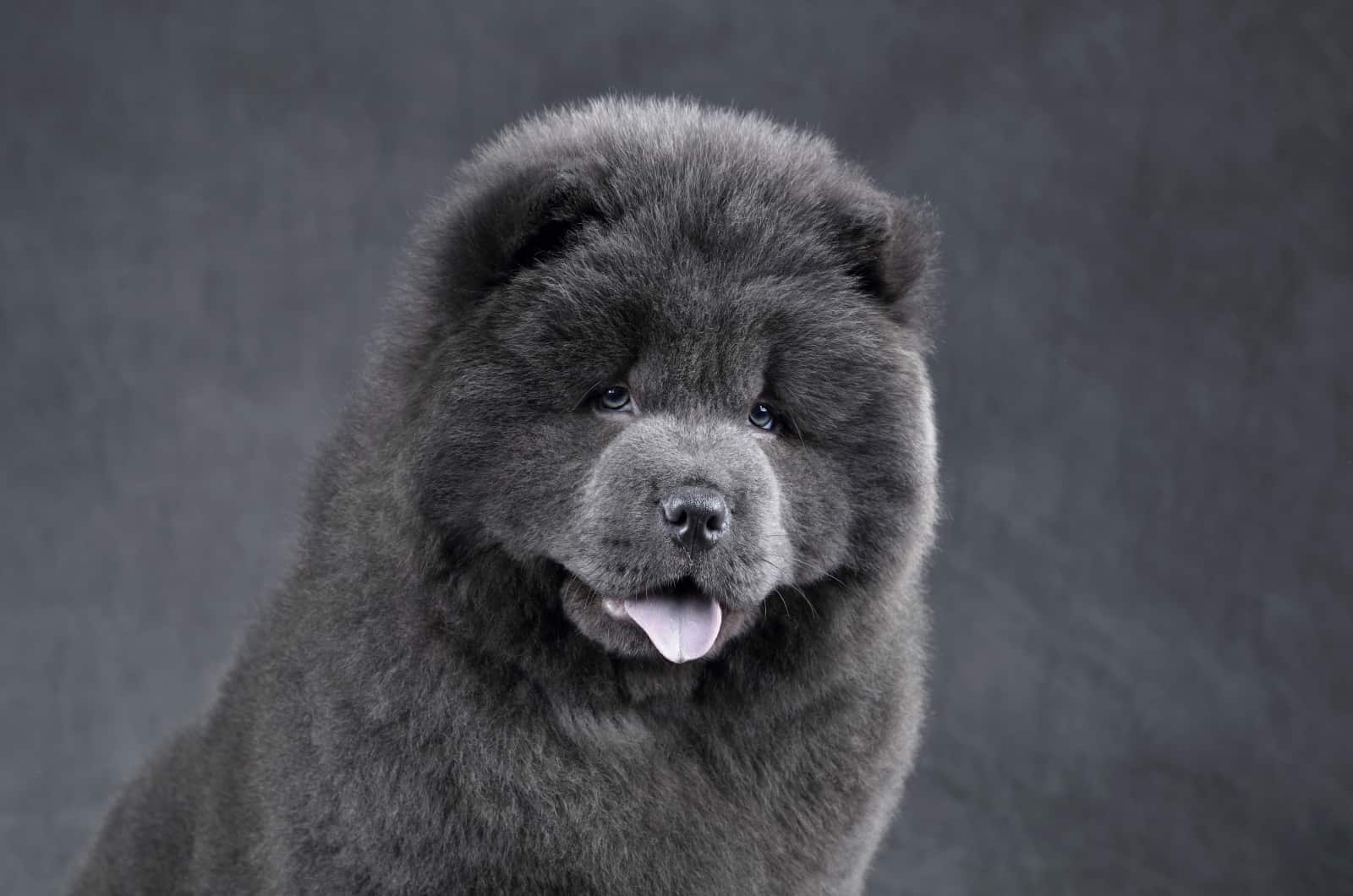The recognizable-looking blue Chow Chow has had its independent personality compared to that of a cat. An interesting way to start the story about this dog breed, huh?
If you’re searching for a snuggle friend, this is probably not the breed for you because they can be distant, even with their owner for a certain amount of time, and outright wary of strangers.
However, the proper person can find the Blue Chow Chow puppy to be a fiercely devoted friend.
Despite being purebred canines, you might find them in shelters or with rescue organizations. Don’t forget to adopt! If you intend to bring a dog home, let the purchase from a breeder be a second option!
These puppies may require some things to be done on their terms because they are an independent breed that requires patience and consistency. Beware, new pet owners.
Although these dogs may adjust to apartment living, they require a lot of exercise, and also, they don’t like spending extended periods of time alone at home. You can have a devoted, guarding furry family member by offering skilled training and plenty of physical activity.
This Chow dog breed from Tibet has had its breed standard accepted by the American Kennel Club (AKC) almost 130 years ago… in 1903.
For a complete list of Blue Chow Chow characteristics and information, see below!
What Is A Blue Chow Chow?
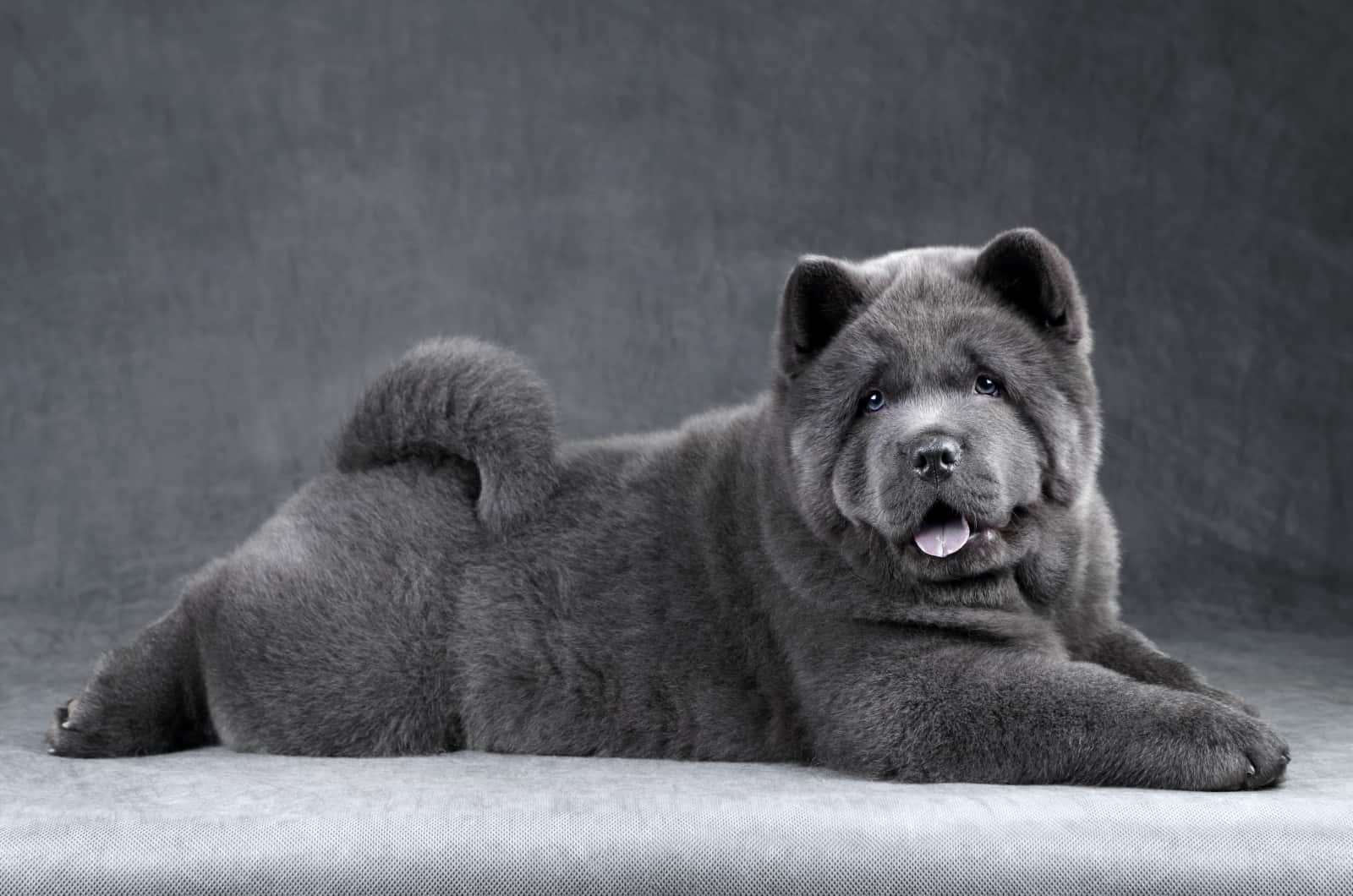
It is believed that the blue Chow Chow has existed since the dawn of recorded history. To learn more about the Chow’s ancient ancestry, historians as well as dog researchers are still putting the pieces of historical and archeological information together.
One of the oldest and most noble dog breeds on the planet is the blue Chow Chow. Even today, seeing a blue Chow Chow stroll by is like witnessing history in motion.
Today’s Chow Chows can be seen living anywhere “their” people do, from city highrises to rural farms. You can always tell a Chow Chow when you see one because of its lion-like head ruffle and royal demeanor.
The Chow Chows from the monasteries were a little bit smaller and more slenderly constructed than the Chow Chows that Dr. Abshagen saw in Europe.
He described them as having a gloomy look, and being wrinkle-free; however, these blue Chow Chows had their distinctive, wry grin, and he fell head over heels for them.
According to rumors, blue Chow Chows served as dogs employed in the monasteries as guard dogs, herders, and herding animals.
As a side note, blue Chow Chow puppies are born gray, and they frequently have a gray or a slate-colored nose. The only Chow color without a mandatory black nose is this one, although it cannot have a brown nose.
History Behind This Dog Breed
Over 3,000 years have passed since the blue Chow Chow’s earliest recorded appearance in writing. A Berlin museum currently has Chow Chow dog pottery from the Han dynasty (206 BC until 220 AD) on display.
As “the wild dogs of China,” these dogs were characterized and known in London. There are numerous vivid tales and folklore that speculate on the topic of how the blue Chow Chow acquired its distinctive blue/black tongue.
People frequently assume that the Chow Chow originated in the icy northernmost regions of Asia due to its thick coat. DNA research, on the other hand, places the dog’s first years in southern China, which is actually significantly warmer for most of the year.
Chows have performed a variety of functions for people, including serving as companions, as food, and as protectors!
The sole native working and hunting dog in China (and Mongolia) is the blue Chow Chow, which also comes in various Chow coat colors.
Buddhist monks specifically raised the blue Chow Chow to protect the monasteries and aid in the herding of animals. In Chinese towns, Chow Chows were utilized for sled pulling in the winter, along with herding cattle, hauling supplies, and keeping an eye on people and livestock near monasteries.
Naturalist, Gilbert White, wrote about the Chow in his 1781 publication: Natural History & Antiquities of Selborne, published in Great Britain. He featured two Chow Chows that his neighbors had brought back from Canton (now Guangdong) as part of his views on rural life.
However, it wasn’t until about a century later that Chow Chows started to be imported often. Queen Victoria, who adored dogs, developed a fascination with the breed, which increased public awareness of it, and in 1895, a breed club was founded in England.
What Does The Blue Chow Chow Look Like?
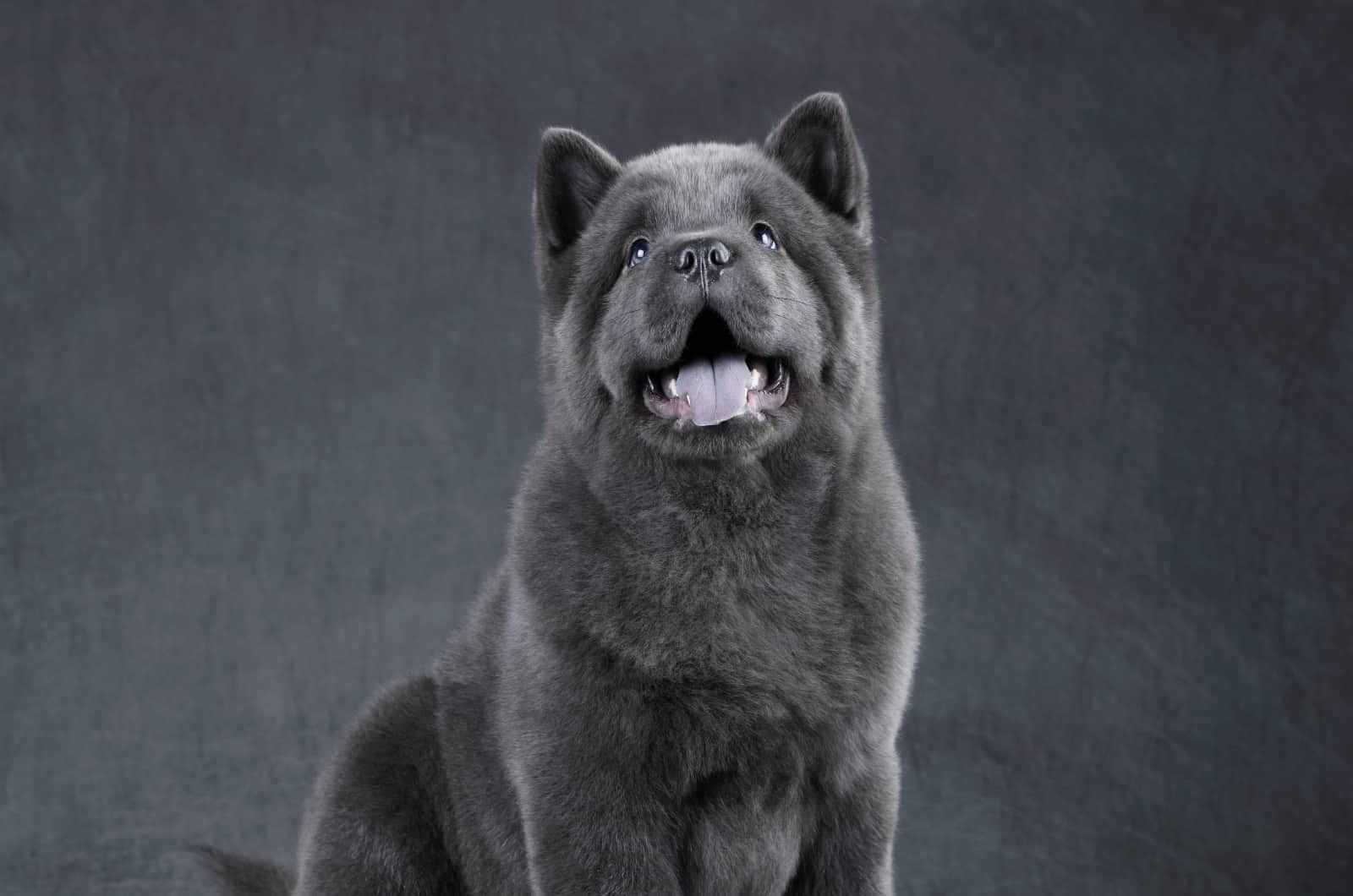
These compactly-muscular, medium-sized canines may appear larger than they actually are due to the blue Chow Chow’s aristocratic and reserved demeanor!
Nevertheless, an adult blue Chow Chow rarely grows taller than 20 inches, and weighs between 45 and 70 pounds.
The Chow Chow is more like a cat in terms of fastidiousness and cleanliness rather than a dog in terms of “doggie stink.” Due to the Blue Chow Chow’s two extra adult teeth, this dog possesses 44 adult teeth as opposed to the more common 42 teeth.
Every blue Chow Chow steals the show. They distinguish themselves from others due to their thick coat, distinctive pace, ramrod-straight stance, and intense dark eyes.
The blue Chow Chow in particular can draw a lot of attention. The Chow’s distinctive coat color just adds further mystery to its illustrious past.
The Chow Chow’s blue coat is merely one of the five acknowledged Chow Chow dog coat hues, which also include red, cream, black, blues, and caramel.
The Chow Chow’s coat can occasionally resemble a dog that placed a paw in an outlet!
The thick, double-layered coat of the Chow Chow developed to keep them comfortable and protected while working outside during the bitter winters of their native area.
Chow Chow Coat Types
The noticeable fur ruff around the head and shoulders as well as the additional fur (referred to as “feathering”) on the tail and legs are absent from the smooth-coated Chow Chow.
The dilute gene, which alters how the typical black coat color displays is the cause of the blue Chow Chow’s fur.
The color ‘blue’ can be found in a range of tones, from light to dark, and it is actually a type of gray.
The reddish coloring that occasionally appears in blue Chows is mostly caused by seasonal sunlight exposure and regular coat changes. As the adult coat develops, the Chow’s heavy coat may “blow” or fall out in clumps.
When Chows reach adulthood, they moderately shed all year long. They do a significant seasonal shed, known as “blowing their coat” twice a year. During their “coat blow” season, Chow dogs may need to be brushed and groomed more frequently than once a day.
What Is The Blue Chow Chow’s Temperament?
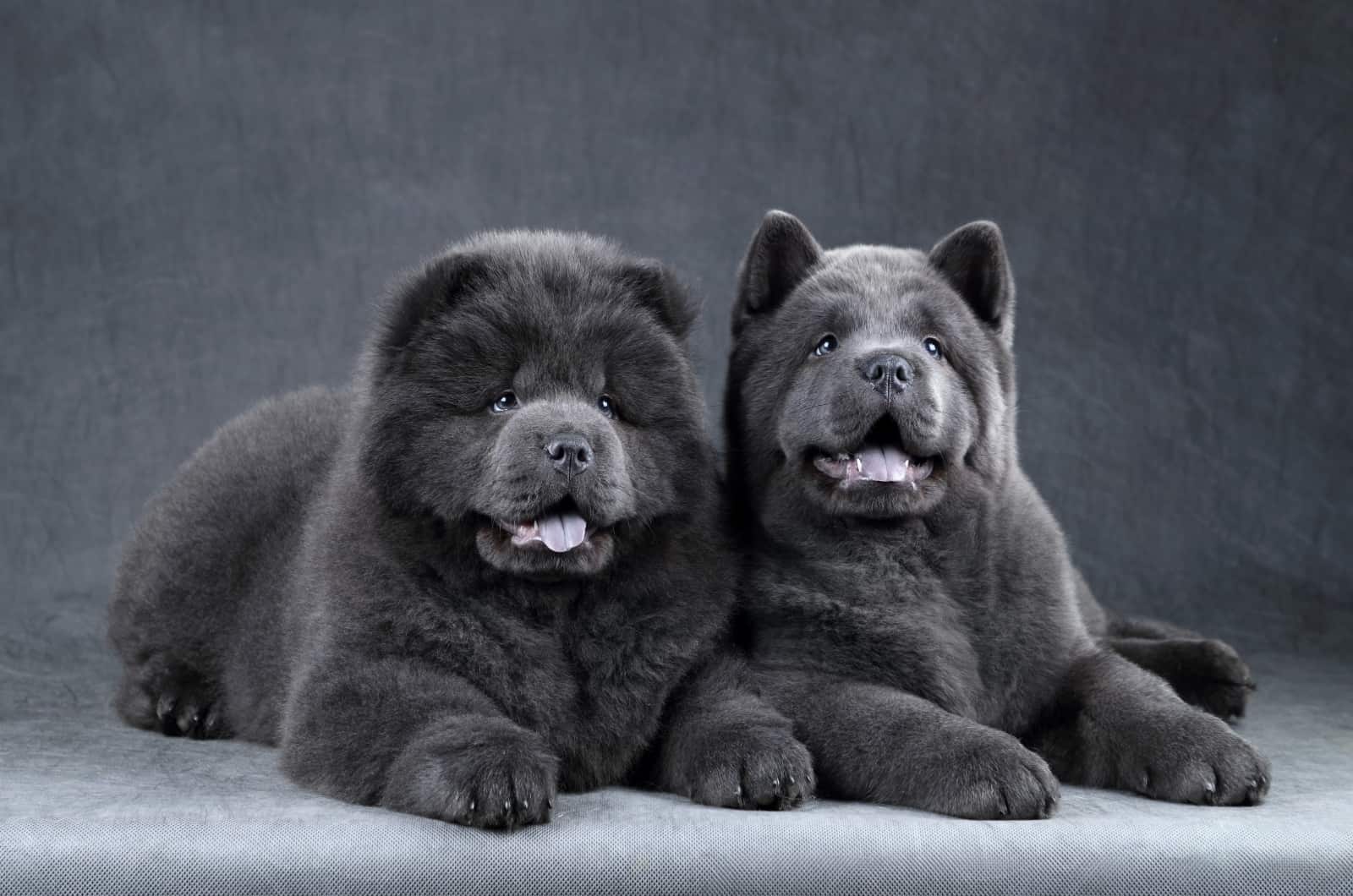
Uniquely, Chow Chows are frequently referred to as a cat-like dog breed. He is self-reliant and respectable… not a silly and playful dog like most of them!
He is reticent among strangers, and won’t show much interest in them. Even if they fuss over him and give him delicious delicacies, he will most likely turn his nose up at them. In that sense, he definitely qualifies as a diva doggo.
But, if an outsider poses a threat to its owner’s household, the Chow will intervene to protect him. He will make certain that everyone comprehends how fiercely he guards his family. Before things get hot, he is cool and collected.
To properly socialize a puppy, a master with experience working with dominant dog breeds is required. In the wrong hands, a Chow Chow can become aggressive.
He doesn’t enjoy attention either, and only wants it when he wants it. Once more, quite comparable to a cat!
He’ll let you know if he needs a cuddle, but if not, he’s content to sleep on the porch by himself and enjoy himself.
He is quite low maintenance in this regard, and many people appreciate his independence. But he’s not the best option for somebody searching for a constant snuggle partner. He is an independent dog that doesn’t require an owner… or so he believes.
He does, however, like his humans, and enjoys having a good time when the mood strikes. Chinese emperors appointed him as their watchdog because he makes an excellent watchdog.
Additionally, he is calm and able to fit into most family situations. Overall, the blue Chow Chow is a great choice if you love dogs, but also appreciate how low-care cats are.
Are Blue Chow Chows Good Family Pets?
Chow Chows can either develop close relationships with just a single person or their immediate family. However, they are wary of strangers.
Blue Chow Chows can get along with kids when they’re reared with them, but they aren’t a rough-and-tumble dog that will put up with much maltreatment from young children.
Families with older kids who know how to care for a dog are more suited for owning a Chow.
Similar to any dog, make sure kids understand how to interact with and pet your Chow, and always keep an eye on any encounter between canines and small children in order to make sure neither party bites or pulls the other’s ears.
When socialized and trained properly, chows can get along with cats and other dogs, especially if they are exposed to them as puppies, making them good family dogs.
However, they work best with canines of the opposing sex; canines of the same gender can result in conflict.
Is The Blue Chow Chow A Healthy Dog Breed?
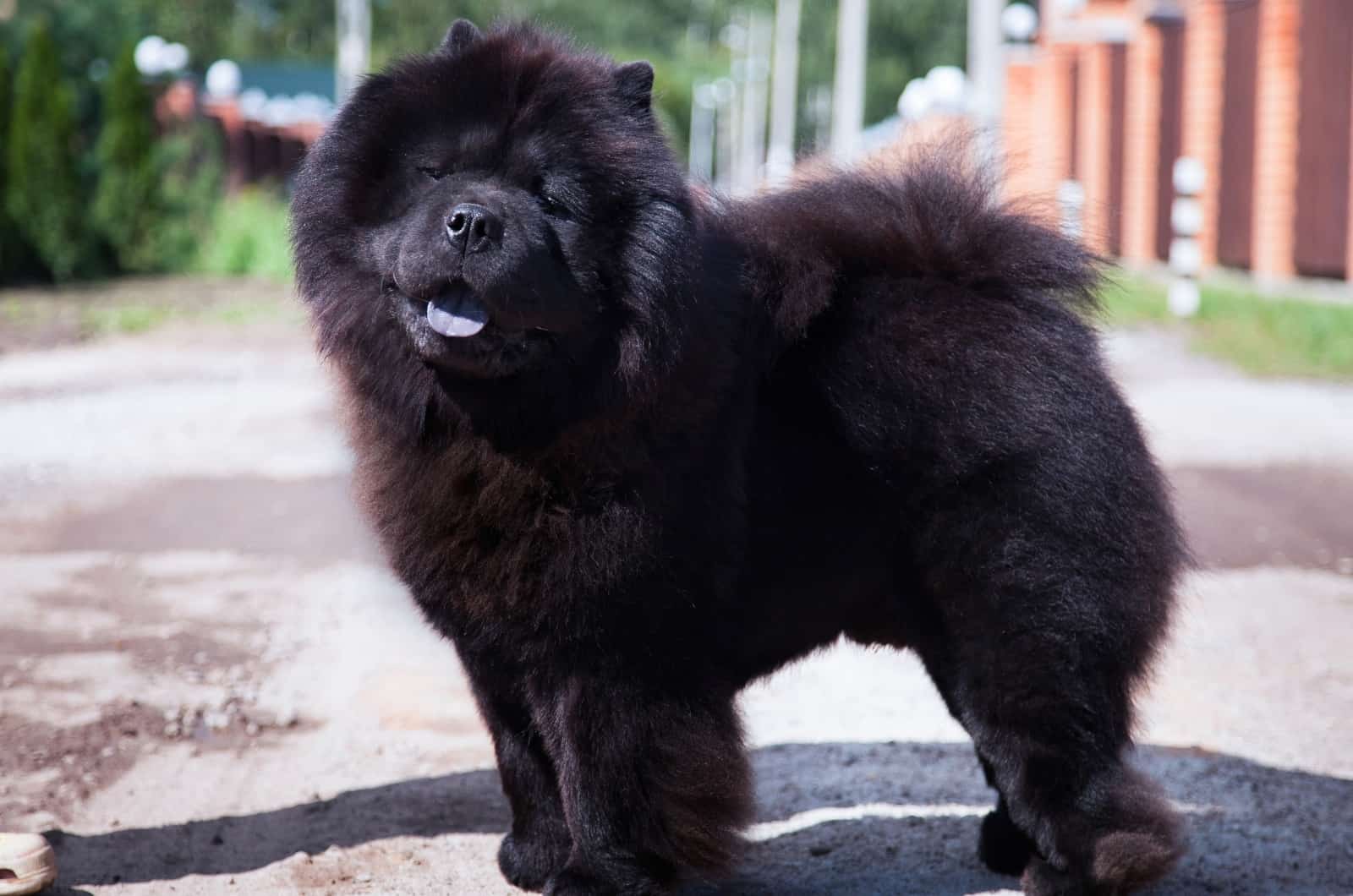
Chow Chows are typically in good health, although like all breeds, they might develop specific illnesses. Not every Chow will contract one or more of these illnesses, but if you’re thinking about getting one, you should be aware of them.
Find a reputable breeder who will provide you with the health clearances for both of your blue Chow Chow puppy’s parents if you are purchasing a puppy. Health certifications attest to a dog’s having undergone testing and receiving a clean bill of health.
You might anticipate seeing the Orthopedic Foundation for Animals (OFA) hip clearances, and the Canine Eye Registry Foundation (CERF) certification of normal eyes in Chows.
Health clearances aren’t given to dogs under two years old since some health issues don’t manifest themselves until a dog achieves full maturity. Search for a breeder who waits until her dogs are two to three years old to breed them.
Possible Health Problems Of The Blue Chow Chow Dog
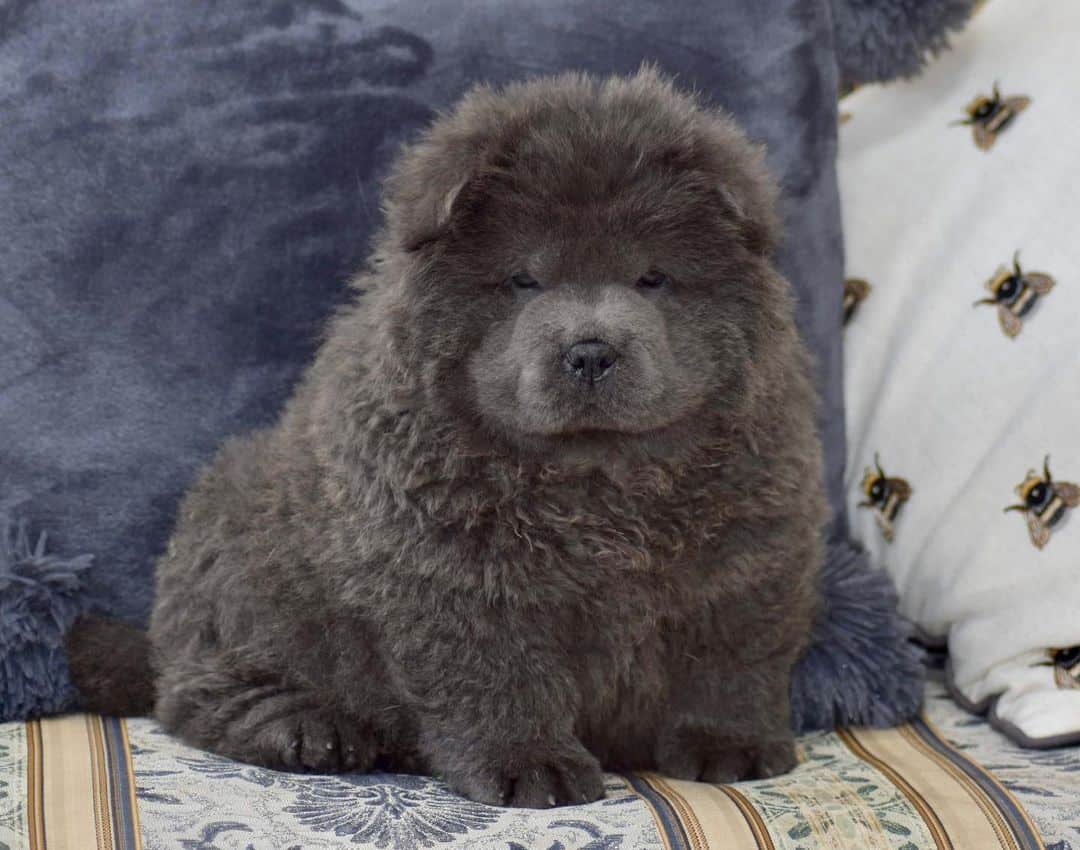
The Chow Chow is a breed of relatively healthy dogs, and it can live for eight to twelve years. You can do a lot of things to ensure that your Chow is well.
The easiest methods for keeping him healthy are to feed him the greatest nourishment, keep him active every day, and keep up to date with regular veterinary checkups.
Working with a breeder of high caliber might also reduce health issues.
1. Hip Dysplasia And Elbow Dysplasia
In large and medium-sized dogs, hip as well as elbow dysplasia are prevalent problems. Working with a high caliber breeder is essential since deformation of the elbow and pelvic girdle can occasionally be inherited from the parents.
When pups grow too quickly, the bones develop unevenly, increasing the likelihood of this happening.
It may eventually lead to arthritis and mobility issues. Exercise intolerance, stiff joints, and difficulty rising or descending smoothly are typical symptoms.
2. Eyelid Entropion
Entropion is a disorder when the eyelid slides inward, rubbing the dog’s delicate cornea with the eyelashes as well as surrounding hair.
One or both of the lower and upper eyelids may be impacted. Entropion causes eye irritation, and if left untreated, it can result in corneal ulcers. Entropion may either be inherited or arise as a result of another problem.
Entropion in dogs causes overall eye pain, rubbing of the face, and sensitivity to light.
Giant and sporty breeds frequently have mucous discharge coming from the outside corner of their eyes, while short-nosed breeds frequently have excessive tears, red eyes, and excessive blinking.
The symptoms of secondary entropion in dogs vary depending on the underlying etiology, but they typically involve ocular drainage and squinting. The cornea could cloud over and appear white or bluish if the entropion results in corneal ulcers.
3. Hypothyroidism
Here, the thyroid hormone needed for regular bodily processes is not produced by the adrenal gland in sufficient amounts. This may trigger a number of additional health issues.
The most typical signs of hypothyroidism, which include fatigue, loss of hair, excess weight, and dry skin, should be seriously addressed. He will typically need daily medicine to maintain a normal lifestyle.
4. Patella Luxation
In essence, the kneecap is dislocated and it glides out of place. It might hurt, and you’ll see that your Chow might have trouble moving around. He’ll also stomp out, just like canines do when they first attempt to walk in boots.
This condition may leave your dog feeling helpless, without any self-esteem, and also starting to eat less. It is essential that you get your dog from a reputable breeder, and to do regular, at least yearly vet checks.
How To Take Care Of A Blue Chow Chow
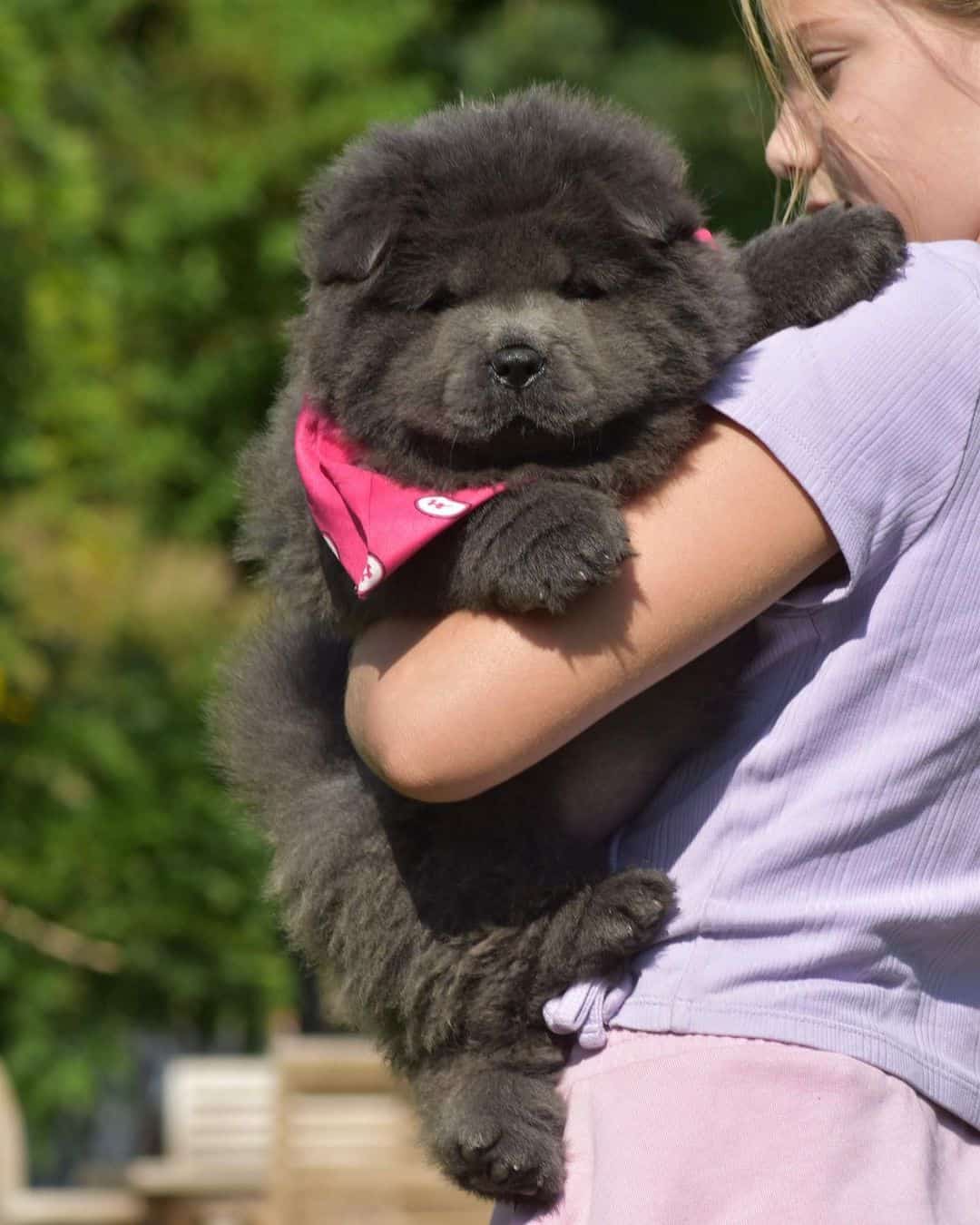
In order to take care of any dog breed with a double coat, you will need a special set of skills. The surrounding area of their deep-set, beautiful dark eyes will sometimes need to be wiped with a wet wipe or a cloth (just as the Pug’s), along with their ears.
This purebred dog needs to have its undercoat very well taken care of, which includes daily brushing out knots and matting, which will happen. This doggy isn’t known as a lion dog without a reason – their coat tells a story on itself.
Grooming And Cleaning
Three times weekly should be allotted for brushing your blue Chow Chow in order to maintain the coat’s condition and prevent loose hair from getting on your furnishings and clothes.
The coat needs particular care during the season when blue Chow Chows shed heavily. If the coat is frequently brushed, they don’t smell dog-like.
A medium, coarse-toothed, stainless steel comb, medium-sized slicker brushes for the legs, medium pin brushes for the longer body coat, and a sprayer of dilute fur conditioner are all necessary for brushing.
A dry coat should never be brushed as the hairs may break. You’re more likely to overlook mats and knots if you don’t brush all the way to the skin’s surface.
If your Chow spends a lot of time playing outside and getting muddy, you should probably bathe him more regularly than once a month.
Other grooming requirements include nail maintenance and dental hygiene. For the purpose of removing bacteria and tartar formation, brush your Chow’s teeth at least twice or three times every week. Daily is preferable.
If necessary, either once or twice per month, trim his nails. The nails are too long if you can hear them clicking on the floor. Short nails help to maintain healthy feet and stop painful, bleeding tears.
To get your Chow accustomed to being groomed, begin when he is still a puppy. Dogs are sensitive when it comes to their feet, so handle his paws regularly and examine his lips and ears.
You’ll create the framework for simple veterinary checks and other management when he becomes an adult if you make grooming a rewarding experience packed with praise and rewards.
Exercise Needs
Chows can live in a range of dwellings, including palaces and apartments. However, they must always reside indoors with their owner, and never be confined to a kennel or a back yard. Keep them inside during oppressive weather because they can’t handle the heat well.
An adult blue Chow Chow needs regular exercise to stay healthy and happy, just like any other dog, but he just needs a little bit — he’ll be OK with a few 15-minute walks per day or one longer walk.
Despite the fact that a Chow Chow is a homebody, and is not prone to wandering, if you have a yard, you should still have a safe fence to keep people out and to protect your dog from traffic.
This dog requires surprisingly little upkeep in terms of his activity requirements! If you have a hectic life and don’t have much time for long hikes, this is perfect. Or… if you like watching box sets over going on a challenging hike with a dog workout partner.
This calm dog enjoys a little stretch and short strolls around the park or community. He only needs to invest a total of 30 minutes outside each day in order to meet his exercise requirements.
A word of caution: Just because he seems low-energy doesn’t mean you should forgo walks. If you do, you’ll quickly start to see behavioral issues, including agitation, irritability, and destructive conduct.
The scowling Chow will easily chew through your nicest sofa in 10 minutes due to his extreme strength and tenacity. The greatest option would be a cat if you want a dog that doesn’t require any walking.
Nutrition
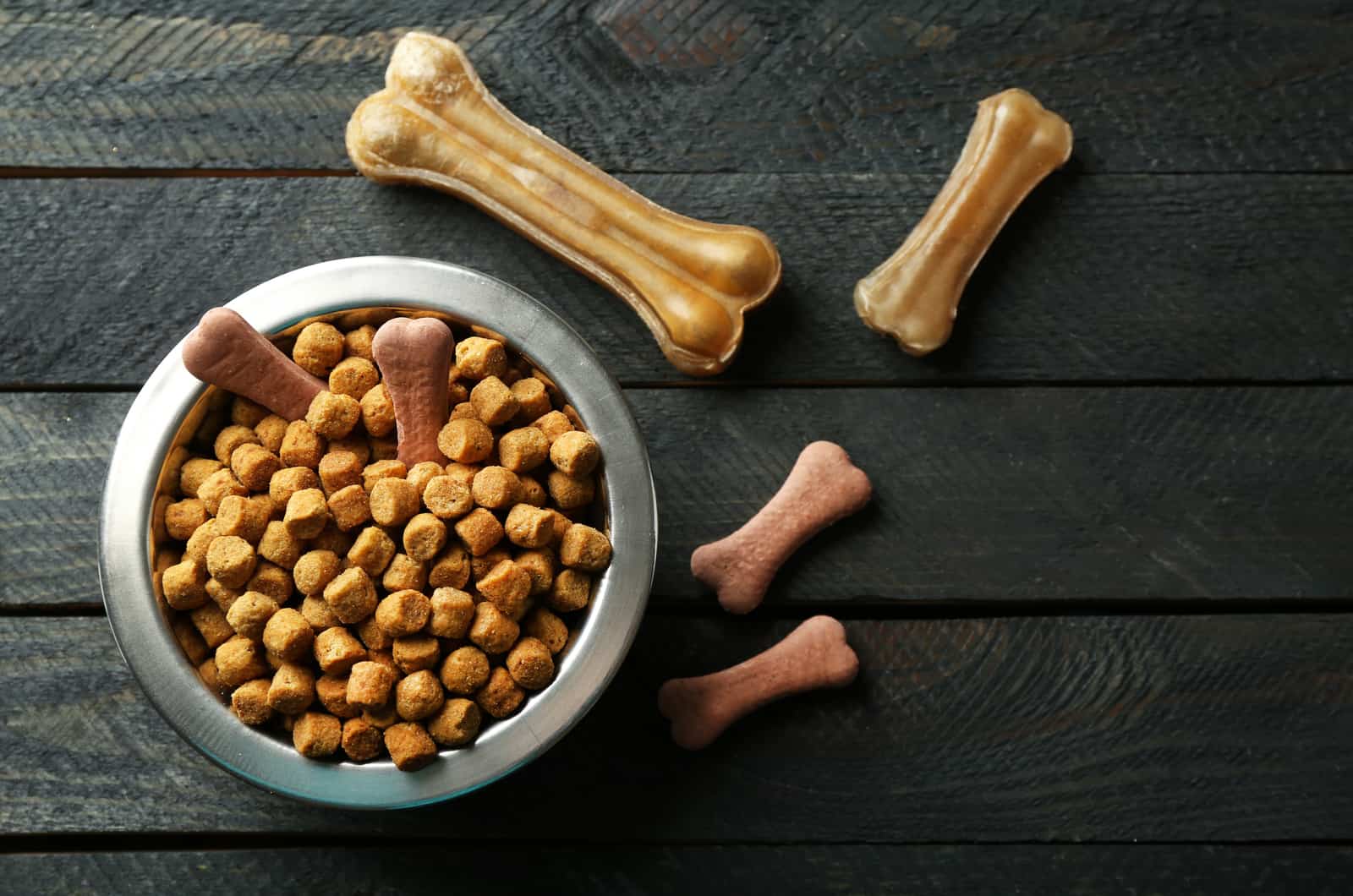
The Blue Chow Chow is an extremely greedy puppy that is constantly hungry. Therefore, you must establish boundaries because he has zero! Every day, the typical Chow will eat between two and three cups of premium kibble.
The age, gender, height, and degree of energy of your Chow will determine how much you should feed him or her. Always adhere to the directions on the packaging to prevent overfeeding. Change him to a weight-management kibble if you find that he is gaining weight.
Give your Chow food made for large-breed dogs, especially while they are young. Any dog that will mature weighing more than 50 pounds needs to be given large-breed dog food.
These kibbles have the ideal nutrition for slowing fast bone growth. Additionally, providing him this can reduce his risk of having joint dysplasia. Nothing else will work, therefore.
The Chow must consume healthy omega-3 essential fatty acids because they have a significant impact on his general health. It will keep his skin and coat healthy as well as his joints, eyes, heart, and cardiovascular system.
It is essential to feed him high-quality kibble because low-quality kibble frequently lacks these lipids. Watch out for substances like flaxseed, fish, fish oils, and fish meals.
Socialization And Chow Chow Dog Training
Although crate training is highly advised, Chows are easily trained to go inside. Crates facilitate housebreaking and prevent your Chow from consuming objects while you’re gone.
But, don’t leave your Chow cooped up in the crate for too long; it’s a utility, not a prison. A Chow is most comfortable with you.
Chows are perfectly capable of picking up on whatever you can teach them, and most of the time, all it takes to correct them is a verbal reprimand. Never hit a dog – it’s especially bad for this breed if you do.
The fiercely independent and proud Chow will never retaliate physically. You won’t have any difficulty training him if you earn his respect when he’s a puppy by being firm and consistent.
However, if you constantly let this adorable puppy have his way, and then attempt to teach him, you will undoubtedly run into difficulties.
Interesting Facts About This Dog Breed
- Together with the famous Shar-pei, these two dog breeds are the only ones that have the distinct blue or black tongue.
- Some canine genetic research suggests that the Chow Chows that we know of today were once a mixed dog breed from the Tibetan Mastiff and the Samoyed.
- Sigmund Freud had a blue Chow Chow! He claimed to have owned one, and used it as a therapy dog. Some believe that he utilized it to gain diagnosis as well as just to let the patient relax.
- Martha Stewart is one of the Chows’ more recent admirers; they occasionally appear together on her TV program.
- In the 1920s, Chow Chows became the trend among many of the rich and popular. Even the White House was reached, where Tim, a red Chow, and Blackberry, a black Chow, were kept by President Calvin Coolidge and his wife.
Final Word
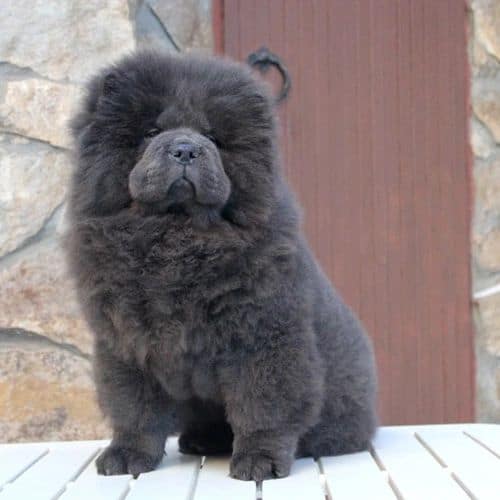
The blue Chow Chow (also known as the blue Chow, for short) is a remarkable dog with deep-set eyes and a huge head that is enhanced by a mane of fur. Despite what his appearance might have you believe, a properly-raised Chow is not aggressive.
The Chow is thought to combine the grace and independence of a cat, the loyalty and devotion of a dog, the dignity of a lion, the drollness of a panda, and the cuteness of a Teddy bear.
In keeping with a breed that was historically housed in imperial Chinese kennels, he is also haughty and distant.
Although he dislikes being fussed over or cuddled, he will be a quiet, devoted friend to his bestie, and his devotion will also stretch to other members of the family.
He will happily accept youngsters if he has been reared with them, but because he won’t put up with mistreatment, he is best suited for households with older children who are familiar with how to treat animals.
He will handle strangers with composure if he has several pleasant interactions with them while still a pup. But, because they are such a fiercely protective and territorial species, they will provide a clear message to anyone near them without their permission.
